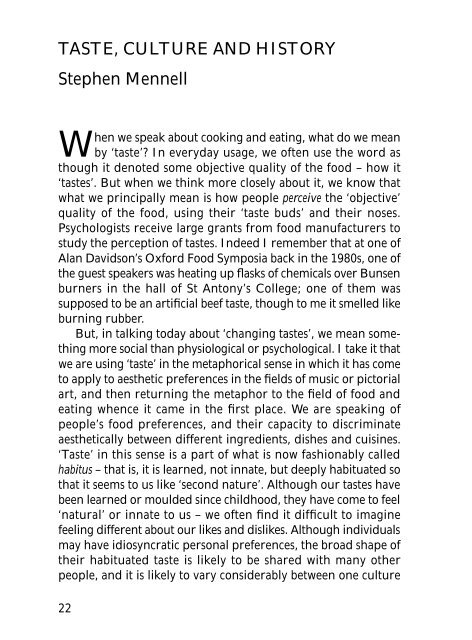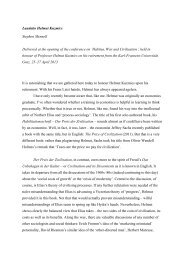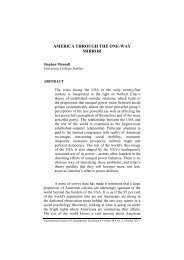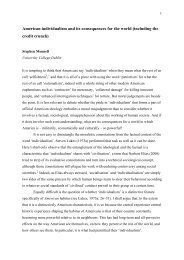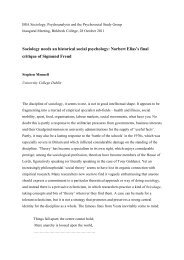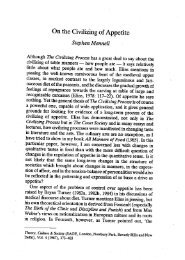Taste, Culture and History - Stephen Mennell
Taste, Culture and History - Stephen Mennell
Taste, Culture and History - Stephen Mennell
- No tags were found...
Create successful ePaper yourself
Turn your PDF publications into a flip-book with our unique Google optimized e-Paper software.
TASTE, CULTURE AND HISTORY<strong>Stephen</strong> <strong>Mennell</strong>When we speak about cooking <strong>and</strong> eating, what do we meanby ‘taste’? In everyday usage, we often use the word asthough it denoted some objective quality of the food – how it‘tastes’. But when we think more closely about it, we know thatwhat we principally mean is how people perceive the ‘objective’quality of the food, using their ‘taste buds’ <strong>and</strong> their noses.Psychologists receive large grants from food manufacturers tostudy the perception of tastes. Indeed I remember that at one ofAlan Davidson’s Oxford Food Symposia back in the 1980s, one ofthe guest speakers was heating up flasks of chemicals over Bunsenburners in the hall of St Antony’s College; one of them wassupposed to be an artificial beef taste, though to me it smelled likeburning rubber.But, in talking today about ‘changing tastes’, we mean somethingmore social than physiological or psychological. I take it thatwe are using ‘taste’ in the metaphorical sense in which it has cometo apply to aesthetic preferences in the fields of music or pictorialart, <strong>and</strong> then returning the metaphor to the field of food <strong>and</strong>eating whence it came in the first place. We are speaking ofpeople’s food preferences, <strong>and</strong> their capacity to discriminateaesthetically between different ingredients, dishes <strong>and</strong> cuisines.‘<strong>Taste</strong>’ in this sense is a part of what is now fashionably calledhabitus – that is, it is learned, not innate, but deeply habituated sothat it seems to us like ‘second nature’. Although our tastes havebeen learned or moulded since childhood, they have come to feel‘natural’ or innate to us – we often find it difficult to imaginefeeling different about our likes <strong>and</strong> dislikes. Although individualsmay have idiosyncratic personal preferences, the broad shape oftheir habituated taste is likely to be shared with many otherpeople, <strong>and</strong> it is likely to vary considerably between one culture22
of thought. The rejection of some available foods <strong>and</strong> preferencefor others may have been all the more possible if, as MarshallSahlins famously argued in Stone-Age Economics (1972), for earlyhumankind food was relatively abundant <strong>and</strong> gathering it leftplenty of time for leisure <strong>and</strong> reflection. On the other h<strong>and</strong>, it canbe pointed out that early humans also endured levels ofvulnerability <strong>and</strong> unpredictable danger – from disease, accident,natural disasters, other animals – that are almost inconceivable tomodern people, <strong>and</strong> the levels of fear associated with such levelsof danger probably served to minimize the foresight associatedwith highly developed ‘taste’. Some insight into the fierce satisfactionof appetite that may have been characteristic of suchconditions may perhaps be gleaned from Ray Allen Billington’saccount of fur trappers in the Rocky Mountains in the periodfrom 1825 to 1845 – who were pursuing one of the most dangerousways of life known to modern history:While the ribs were sizzling, he often began his meal bydrinking some of the warm blood, which he insisted tastedlike milk. This might be followed by the buffalo liver, eatenraw <strong>and</strong> flavoured with the contents of the gall bladder, orby a soup made from a pound or two of rich marrowextracted from the leg bones <strong>and</strong> cooked with blood <strong>and</strong>water. This thick mixture turned the stomachs ofeasterners but made the faces of trappers ‘shine withgrease <strong>and</strong> gladness’. The intestines were eaten next,roasted until they were puffed with heat <strong>and</strong> fat <strong>and</strong>sizzling with escaping steam. These ‘boudins’ the men sliddown their throats without chewing; on occasion twotrappers would start at opposite ends of a great pile ofintestines <strong>and</strong> work their way to the middle, each eatingfaster <strong>and</strong> faster to get his share … (1977: 38)Whether or not early humans had well developed systems forclassifying what they ate <strong>and</strong> did not eat, it should not beforgotten that these were small, local <strong>and</strong> self-sufficient b<strong>and</strong>s whocould only eat what was immediately available to them in their24
immediate environment. They may have rejected some of whatthey could have eaten, but the range of comestibles would alwayshave been far smaller than in the modern world, where foods ofdiverse ecological <strong>and</strong> economic provenance are traded across thewhole globe, so that everything is available all the time in thegreat world cities for those who can afford it. A book like AlanDavidson’s North Atlantic Seafood (1979) is symptomatic of ourglobalizing world, <strong>and</strong> would have been inconceivable only a fewdecades ago. The diet of most pre-industrial groups was rathermonotonous <strong>and</strong> – by the st<strong>and</strong>ards of today – boring. There isa story, probably apocryphal, about an African tribe whose staplediet was millet porridge; an anthropologist is supposed to haveintroduced them to grilled fillet steak to see what they thought ofit. They are supposed to have replied, ‘Well, it’s very good – butit’s not as nice as millet porridge.’INTERDEPENDENCE, STRATIfiCATION AND CUISINEMy good friend Jack Goody, in his book Cooking, Cuisine <strong>and</strong> Class(1982), compared West African <strong>and</strong> Western European cuisines,arguing that refined <strong>and</strong> elaborate cookery or hautes cuisines onlyemerged in highly unequal <strong>and</strong> markedly stratified societies. Thepeople he had studied as an anthropologist in West Africa livedin smaller-scale <strong>and</strong> much more egalitarian societies, whereeveryone ate much the same, the range of dishes was relativelylimited, <strong>and</strong> eating played little part, if any, in status competition.Jack mildly criticized me, when my book All Manners of Food waspublished three years after his, for being sidetracked, as he sawit, into the relatively smaller problem of explaining how French<strong>and</strong> English tastes came to develop differently. In a way he wasright, but I didn’t want to write the same book as he had! But, inreturn, <strong>and</strong> after many years’ delay, I’d like to offer a mildcriticism of Jack’s argument, <strong>and</strong> a modification to it as well.I’d like to argue that a high degree of social inequality <strong>and</strong>elaborate social stratification are perhaps necessary, but notsufficient, conditions for the emergence of elaborate cuisine <strong>and</strong>for culinary tastes to be increasingly in flux. For that, it is also25
necessary to have long – <strong>and</strong> lengthening – chains of socialinterdependence. Stratification <strong>and</strong> large-scale webs of interdependencemay indeed be interconnected with each other, butthey are not the same things.It isn’t just elaborate social stratification that is necessary forrefined <strong>and</strong> changing taste. For instance, in the European MiddleAges, before the Black Death, nutrition was very unequally distributedbetween members of the various estates – <strong>and</strong> that wasespecially true of meat, with the peasantry’s diet dominated byvegetable <strong>and</strong> dairy products. The upper strata may have beenless likely actually to go hungry in times of dearth, but it wouldappear that even the warrior aristocracy ate essentially theseasonal produce of their own l<strong>and</strong>, <strong>and</strong> did not cook it by meansmuch more elaborate than roasting <strong>and</strong> boiling. Now it is true, ofcourse, that the manuscript recipes from a very few major courtstowards the end of the Middle Ages – the Forme of Cury <strong>and</strong>Taillevent, for instance – show something more complicated,characterized by the use of spices <strong>and</strong> flavourings that could havereached these courts only via very long trade routes. But,significantly, there is an old debate about whether this latemedieval haute cuisine for the very few represents a debased form,a remote echo, of the cuisine of ancient Rome, when the chainsof social <strong>and</strong> economic interdependence were indeed longer <strong>and</strong>denser than they were for many centuries afterwards.To put the point more generally, when the social divisionsbetween strata are very deep <strong>and</strong> the interdependence betweenthem is very unequal – when the power that they have over eachother is very unequal – then the power <strong>and</strong> status of the upperstrata is more likely to find expression in quantity than quality, inperiodical displays of indiscriminate heaps of food at ceremonialbanquets for instance, rather than through the quality <strong>and</strong>labour-intensiveness of the cookery.Social competition becomes more intense, <strong>and</strong> the rate ofchange in ‘taste’ accelerates, when the strata of society becomemore closely <strong>and</strong> more equally interdependent. Thus, as far as wecan tell, courtly cuisine did not change very quickly when an even26
sociological evidence should not however, in my view, lead us todeny the abundant evidence of our senses: people of the lowersocial ranks are eating in commercial eating-places <strong>and</strong> samplinga wider variety of cuisines that they did in previous generations.Oddly enough, Warde accused me of ignoring generationalchanges, whereas my argument was in fact about changes fromgeneration to generation rather than about the tastes of particularindividuals during their lifetimes – although such changes probablydo take place, even if they are more difficult to document.In relation to ‘diminishing contrasts’, Warde says that classdifferences are still marked – which indeed they are, if by that onemeans the unequal distribution of resources between the individualswhom one might survey using conventional questionnaires.But the group structure is now much more complex, old-style classinequalities cross-cutting with ethnicity to an extent inconceivablein Europe half a century ago, <strong>and</strong> above all cross-cutting with manydifferent kinds of status group which are defined as much by theirpatterns of consumption <strong>and</strong> taste as by their disposable income.This has led to a culinary pluralism that is the counterpart ofsomething which is more familiar in the arts: the loss of a singledominant style. Styles like the Baroque <strong>and</strong> Rococo enjoyedvirtually unchallenged dominance in their age, more unchallengedindeed than the aristocratic upper classes with which they wereassociated. In a more problematic way so did Romanticismdominate an age <strong>and</strong> spread across the range of the arts. Duringthe last hundred years or more, however, this stylistic unity hasbeen lost. There is a greater diversity of tastes coexisting <strong>and</strong>competing at one time – competing more equally, again like classes<strong>and</strong> interests in society. There is a rapid succession of fashions inartistic styles. And the mixture of elements deriving from severalstyles is common: the label Kitsch is often applied to at least somesuch mixtures (Elias, 1998).It is a reflection of my own taste that I am not very enthusiasticabout so-called fusion food. When I lived in Australia, I noticedthat it has become almost politically incorrect for restaurants toserve food that is recognizably <strong>and</strong> exclusively in a European29
tradition. It isn’t true that the Australian national dish is nowmeat pies with lemongrass – I made that one up – but I havedined out for years with my (true) account of a meal served byDutch caterers at NIAS, Wassenaar, in 1988: kipfilet (chickenbreast) surmounted by a slice of Brie, accompanied by sauerkrautmixed with mangoes <strong>and</strong> lychees.Obviously that dish was made possible by long chains of interdependence,but also by a loosening of the model-setting centresfor taste which would previously have judged such a combinationto be incongruous. But I would also add that the sheer pace ofchange itself probably means that incongruity appears <strong>and</strong>disappears before the arbiters of taste – such as they still are –have a chance to label it incongruous. We shall never again seethe codification of high culinary taste in coherent systems such asthose represented by say, Carême, Escoffier or (to a lesser extent)by the nouvelle cuisiniers of the 1960s – although we may still haveto endure for some time the unanimous view that all one’s foodshould be piled up in the middle of the plate in a one great heap.BIBLIOGRAPHYBillington, Ray Alan 1977 America’s Frontier <strong>Culture</strong>: Three Essays. CollegeStation, TX: Texas A&M University Press.Burke, Peter 1978 Popular <strong>Culture</strong> in Early Modern Europe. London: TempleSmithDavidson, Alan 1979 North Atlantic Seafood. London: Macmillan.Douglas, Mary 1972 ‘Deciphering a Meal’. Daedalus, 101 (1) 61–81.Elias, Norbert 1998 ‘The Kitsch Style <strong>and</strong> the Age of Kitsch’, pp. 26–35 inJohan Goudsblom <strong>and</strong> <strong>Stephen</strong> <strong>Mennell</strong>, eds, The Norbert Elias Reader: ABiographical Selection. Oxford: Blackwell.Goody, Jack 1982 Cooking, Cuisine <strong>and</strong> Class. Cambridge: Cambridge UniversityPress.<strong>Mennell</strong>, <strong>Stephen</strong> 1996 [1985] All Manners of Food: Eating <strong>and</strong> <strong>Taste</strong> in Engl<strong>and</strong><strong>and</strong> France from the Middle Ages to the Present. Second edition, with newAfterword, Champaign, IL: University of Illinois Press.<strong>Mennell</strong>, <strong>Stephen</strong> 2003 ‘Eating out in the Public Sphere in the Nineteenth <strong>and</strong>Twentieth Centuries’, pp. 245–60 in Marc Jacobs <strong>and</strong> Peter Scholliers, eds,Eating Out in Europe: Picnics, Gourmet Dining <strong>and</strong> Snacks since the LateEighteenth Century. Oxford: Berg.Sahlins, Marshall 1972 Stone Age Economics. Chicago: Aldine–Atherton.Warde, Alan 1997 Consumption, Food <strong>and</strong> <strong>Taste</strong>. London: Sage.30


